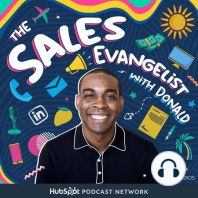30 min listen

TSE 1075: TSE Certified Sales Training Program - "When Should I Talk About Price?"
TSE 1075: TSE Certified Sales Training Program - "When Should I Talk About Price?"
ratings:
Length:
16 minutes
Released:
Apr 18, 2019
Format:
Podcast episode
Description
The trend in sales now is to provide value to your customers, but there must be some kind of exchange in the transaction, so you may find yourself asking, "When should I talk about price?" How do you bring it up? What exactly will you say when it's time to talk about it? Today we're going to share ideas that will help you provide tremendous value and ensure an effective, value-rich conversation for both parties. This is a segment from our TSE Certified Sales Training Program and we're going to share a snippet from one of our training programs and then offer some ideas based upon what you hear. It will let you learn something about selling and offer you an experiment that you can test for yourself. You'll hear the challenges that other sales reps are facing and share with you what has worked for the group members. Taboo We've been taught that it's taboo to talk about money, so many of us shy away from it. New sellers face the biggest challenge, usually because of limiting beliefs. In the past when I was selling software training classes, I didn't understand that it was worth $10,000 for customers to earn their certification over a weekend. I didn't think anyone would be willing to pay it. I didn't understand that for their $10,000 expenditure, they were going to see a $20,000 to $30,000 increase in their earnings over the course of a year. All I knew was that $10,000 was a lot of money. My self-limiting beliefs made me apprehensive, and this is a common problem for new sellers. You must believe in the product or service you're offering and the value it provides to your prospects. When you do that, you'll develop more confidence in your messages, and it won't matter what the course costs. Bring up the money Once you've identified a product you believe in, when do you bring up the money? That depends largely on the product or service that you're selling. If it's software that costs $30 a month and they won't commit, they probably weren't the right fit anyway. Let them go. If you're selling a software solution that you have to customize for the organization, you're going to need more time. You'll have to gather more information in order to give them effective pricing. If the customer can see the prices on your website, they can weed themselves out at the beginning. People who really want to learn more and have more value-rich conversations will engage. In the later conversations, we can discuss what they'll get for their investment. Addressing price We'll tap into emotion by addressing how our product or service will help them. What will happen if the client doesn't get coaching? Why do I need coaching right now? What results will I see if I get coaching? Because people make emotional decisions and then justify those decisions logically, if we build value well, the $1,500 price tag for coaching won't seem like a big deal. The return on their investment, the ability to provide well for their family, and the possibility that they will advance in their careers will justify the cost. In the case of a more complex solution, when the customer asks about price, be honest when you tell them that you can't predict exact numbers right now. If you can't yet determine all the variables and if you can't determine the exact infrastructure, explain that to the customer. Then invest the time to understand the setup and the infrastructure. Find out what challenges the prospect is facing. Be intentional It's possible that the customer is simply fishing, or in other cases that he is simply looking for a ballpark figure. In the latter case, perhaps try giving him a range for other similar clients. Don't give the customer your lowest number if you provide a range. If the cheapest you've done is $5,000 and the most expensive is $20,000, don't offer the $5,000 number. Go a little higher. Instead, offer a higher number, like $8,000 or $10,000. Once they have a number in their minds, you'll determine whether they are truly serious about moving forward.
Released:
Apr 18, 2019
Format:
Podcast episode
Titles in the series (100)
TSE 009: Does The Way You Dress Affect The Way You Sell? by The Sales Evangelist